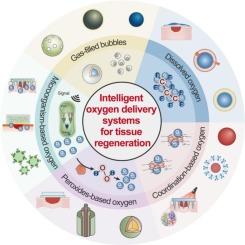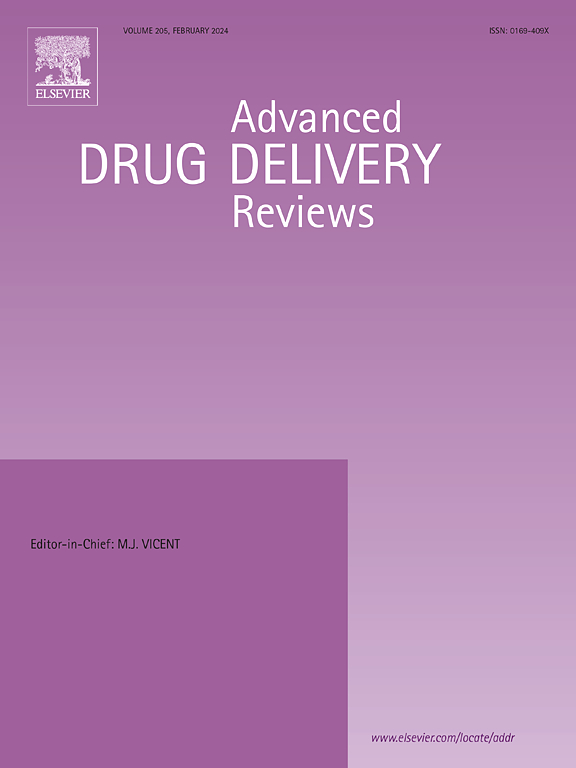Recent advances in intelligent oxygen delivery systems for tissue regeneration
IF 17.6
1区 医学
Q1 PHARMACOLOGY & PHARMACY
引用次数: 0
Abstract
Oxygen plays a critical regulatory role in tissue repair and regeneration. However, in the microenvironment of tissues with vascular damage, hypoxia is commonly present. This not only suppresses cell proliferation and differentiation but also delays angiogenesis and extracellular matrix reconstruction, ultimately hindering the tissue regeneration process. Therefore, developing oxygen delivery strategies that can effectively enhance local oxygen levels has become one of the key approaches to promoting tissue regeneration. Traditional oxygen delivery strategies for tissue regeneration face several challenges, including inadequate sustained oxygen supply, poor targeting ability, and limited biocompatibility. To address these limitations, researchers have developed a variety of “intelligent oxygen delivery systems.” These systems can dynamically regulate oxygen release and achieve tissue-specific targeted delivery by responding to environmental or external stimuli, thereby significantly improving the precision and efficacy of oxygen therapy. This review systematically summarizes the biological functions of oxygen in tissue regeneration, with a particular focus on intelligent strategies for oxygen generation and supply developed in recent years. In addition, this review discusses the oxygen generation mechanisms, release kinetics, biocompatibility, application potential, and limitations of various oxygen delivery strategies. Finally, the review emphasizes that future designs of oxygen delivery systems should place greater emphasis on intelligent regulation, aiming to facilitate their clinical translation in tissue regeneration-related diseases such as chronic wounds, bone repair, and myocardial infarction.


组织再生智能供氧系统的最新进展
氧在组织修复和再生中起着关键的调节作用。然而,在血管损伤组织的微环境中,通常存在缺氧。这不仅会抑制细胞增殖和分化,还会延迟血管生成和细胞外基质重建,最终阻碍组织再生过程。因此,开发能够有效提高局部氧水平的氧输送策略已成为促进组织再生的关键途径之一。传统的组织再生供氧策略面临着持续供氧不足、靶向能力差和生物相容性有限等挑战。为了解决这些限制,研究人员开发了各种“智能氧气输送系统”。这些系统可以动态调节氧气释放,通过响应环境或外部刺激实现组织特异性靶向递送,从而显著提高氧气治疗的精度和疗效。本文系统地综述了氧在组织再生中的生物学功能,重点介绍了近年来发展起来的智能供氧策略。此外,本文还讨论了各种给氧策略的产氧机制、释放动力学、生物相容性、应用潜力和局限性。最后,该综述强调,未来氧输送系统的设计应更加注重智能调节,旨在促进其在组织再生相关疾病(如慢性伤口、骨修复和心肌梗死)中的临床应用。
本文章由计算机程序翻译,如有差异,请以英文原文为准。
求助全文
约1分钟内获得全文
求助全文
来源期刊
CiteScore
28.10
自引率
5.00%
发文量
294
审稿时长
15.1 weeks
期刊介绍:
The aim of the Journal is to provide a forum for the critical analysis of advanced drug and gene delivery systems and their applications in human and veterinary medicine. The Journal has a broad scope, covering the key issues for effective drug and gene delivery, from administration to site-specific delivery.
In general, the Journal publishes review articles in a Theme Issue format. Each Theme Issue provides a comprehensive and critical examination of current and emerging research on the design and development of advanced drug and gene delivery systems and their application to experimental and clinical therapeutics. The goal is to illustrate the pivotal role of a multidisciplinary approach to modern drug delivery, encompassing the application of sound biological and physicochemical principles to the engineering of drug delivery systems to meet the therapeutic need at hand. Importantly the Editorial Team of ADDR asks that the authors effectively window the extensive volume of literature, pick the important contributions and explain their importance, produce a forward looking identification of the challenges facing the field and produce a Conclusions section with expert recommendations to address the issues.

 求助内容:
求助内容: 应助结果提醒方式:
应助结果提醒方式:


